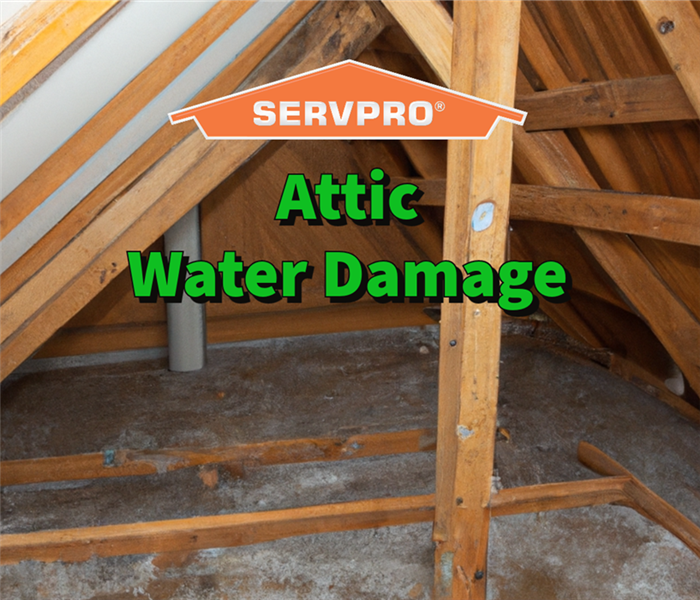Attic Water Damage: Watch Out for These 5 Alarming Causes
10/16/2023 (Permalink)
Attic water damage may go unnoticed for months without the occasional inspection.
Every homeowner dreads the thought of water damage—primarily when it occurs in a less-frequented area of the home, like the attic. Though often overlooked, the attic can be a primary source of significant issues if water damage occurs.
It’s not just about the potential harm; mold growth and structural damage can decrease your home’s value.
In the article, we’re diving deep into understanding the nuances of attic water damage. We’ll also relay how SERVPRO® expertly handled a particularly challenging case in Dayton, Ohio, earlier this year.
What is attic water damage?
Attic water damage is the deterioration that occurs when unwanted moisture or water infiltrates the attic space. This damage can range from staining of the ceiling to rotting of beams and mold growth. The reasons for water infiltration can vary, but the ramifications are equally dire if not addressed promptly.
How does attic water damage occur?
There are various routes for water to make its unwanted entry into the attic. Common causes include:
- Roof leaks: Damaged or missing shingles, faulty flashing, or a compromised underlayment can allow water to seep in.
- Blocked gutters: When gutters overflow, water can wick into the sheathing and flow into the attic.
- Condensation: A poorly ventilated attic can lead to moisture buildup, especially in colder months.
- Ice dams: In winter, ice can form at the edge of your roof, preventing melting snow from draining and causing it to seep into the attic.
- Faulty installations: Incorrectly installed or aged vents, skylights, and chimneys can be culprits, too.
What happens if water gets in your attic?
Once water enters your attic, it remains a complex water problem. If left untreated:
- Structural damage: Wood beams and support structures can weaken, leading to a compromised roof.
- Insulation damage: Wet insulation loses efficiency, leading to higher energy bills and comfort issues.
- Mold growth: Damp environments are breeding grounds for mold, which poses risks.
- Staining: Unsightly water stains can appear on the interior ceilings and walls.
Will wet attic insulation dry out?
Attic insulation cannot effectively dry on its own. While minor moisture may evaporate if given adequate ventilation and time, its efficacy drastically reduces once attic insulation becomes waterlogged. Mold growth becomes a concern, and the insulation often requires replacement.
SERVPRO to the rescue: A recent scenario
Earlier this year, our SERVPRO team received an urgent call from a Dayton, Ohio, homeowner who noticed a brownish water stain spreading on their bedroom ceiling. The team’s swift response uncovered significant attic water damage from a recent storm. At the root, the cause was damaged roof shingles.
The attic insulation was sodden, mold patches had started to form, and the wooden beams were damp. The homeowner was understandably distressed, but our SERVPRO professionals got to work immediately. With our advanced equipment, the team extracted the water, dried out the attic, replaced the compromised insulation, treated and eliminated the mold, and repaired the roof’s damaged section.
Tips to prevent attic water damage
- Regularly inspect your roof: Look for signs of wear and tear, such as missing or damaged shingles, which can be entry points for water.
- Clean gutters and downspouts: Ensure they’re debris-free to allow water to flow away from your home and not seep into the attic.
- Ensure proper attic ventilation: A well-ventilated attic can prevent condensation buildup and help avoid moisture damage.
- Install a vapor barrier: This measure can help keep moist air from your living spaces out of the attic.
- Check for ice dams post snowfall: After heavy snow, look for ice formations at the roof’s edge, which can trap water, forcing it under shingles and into the attic.
By following these tips, homeowners can effectively reduce the risk of attic water damage and safeguard the integrity of their property.
Why choose SERVPRO for attic water damage recovery?
You can always count on SERVPRO after your property suffers from attic water damage; here’s why:
- Quick response: At SERVPRO, we understand the importance of a rapid response. The faster we arrive, the less damage accrues.
- Experienced professionals: Our team has the skills and knowledge to handle any attic water damage situation.
- Advanced equipment: We invest in the latest technology to extract water-dry spaces and restore them to their pre-damage condition.
- Comprehensive service: We handle every step with precision, from initial assessment to final restoration.
- Customer satisfaction: Our commitment is to restore your property and ensure peace of mind.
Conclusion
Attic water damage, while often unnoticed until it becomes a significant issue, can lead to severe consequences for a homeowner. It is crucial to recognize the signs early, understand their implications, and know whom to call for help. Our Dayton case is a testament to SERVPRO’s expertise and dedication in handling such crises.
If you ever face attic water damage, remember that time is of the essence. The quicker you act, the lesser the damage, cost, and inconvenience. Trust SERVPRO to bring your home back to its best. After all, we’re the experts regarding water damage recovery.



 24/7 Emergency Service
24/7 Emergency Service